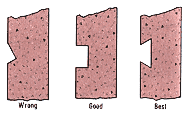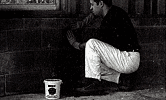Repairing the Leaks
1. If the cracks are in a water-holding vessel, drain the water or wait until it is at a low enough level for the repairs to be done safely.
2. With a hammer and chisel, enlarge all cracks and holes. Cut squarely or undercut; do not make tapered, V-shaped cuts. The cavities should be enlarged to at least ¾" deep and ¾" wide.

3. Remove all loose material from the cavities, then scrub them out with a wire brush and water.
4. With a pail, wooden paddle, and water, prepare only as much QUIKRETEŽ Hydraulic Water-Stop Cement as you can apply in a 3-minute period. Roll the mixed amount in your hands until yu feel it begin to stiffen and become warm. (Be sure to wear gloves when handling this product.)

5. Beginning at the top, press the cement into the cavity with your fingers. Maintain pressure for a few minutes or until the cement sets and the leak stops.
6. Smooth the surface with water and a trowel. Keep the area moist for at least 15 minutes. When all cracks and holes have been repaired, waterproof the entire wall with QUIKRETEŽ Heavy-Duty Masonry Coating, QUIKRETEŽ Masonry Coating, or QUIK-COAT™ Waterproofing Paint for Masonry.
|
